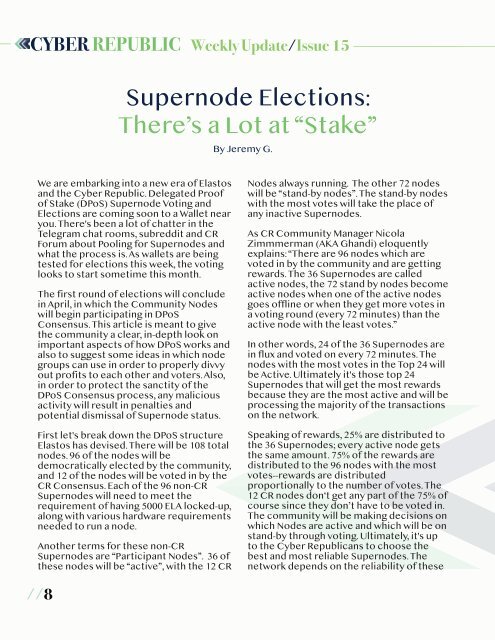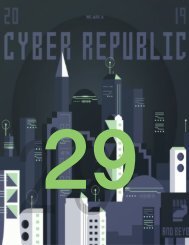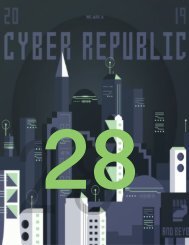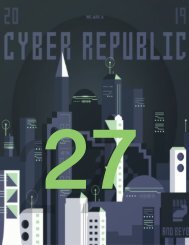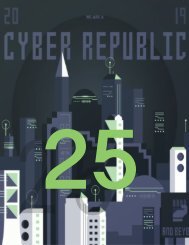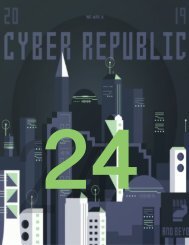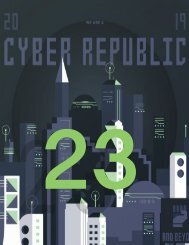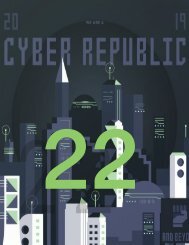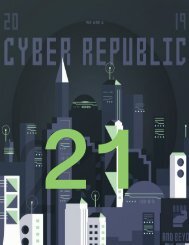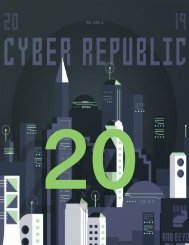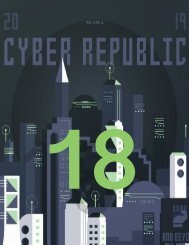Cyber Republic Weekly Update 15
Hello, fellow Cyber Republicans. On the last day of February, the Elastos Foundation published the 2018 Financial Report covering July 2018 to December 2018. https://news.elastos.org/wp-content/uploads/2019/02/Elastos-Financial-Report-English.pdf We will be delving into some details from the report and we’ll share some clarifications Elastos’ leader, Rong Chen, answered for the community. There's also some hot discourse in the community regarding Supernode pools along with a deep dive into DPoS written by yours truly. There is a stunningly active community in the Philippines that, through the voice of Krisha, we’ll be showing their significant activities. And lastly, the Cyber Republic is piling up suggestions on the Cyber Republic website. Vote for the projects you feel are most important. This is our ecosystem and we control our own destiny.
Hello, fellow Cyber Republicans. On the last day of February, the Elastos Foundation published the 2018 Financial Report covering July 2018 to December 2018.
https://news.elastos.org/wp-content/uploads/2019/02/Elastos-Financial-Report-English.pdf
We will be delving into some details from the report and we’ll share some clarifications Elastos’ leader, Rong Chen, answered for the community. There's also some hot discourse in the community regarding Supernode pools along with a deep dive into DPoS written by yours truly. There is a stunningly active community in the Philippines that, through the voice of Krisha, we’ll be showing their significant activities. And lastly, the Cyber Republic is piling up suggestions on the Cyber Republic website. Vote for the projects you feel are most important. This is our ecosystem and we control our own destiny.
Create successful ePaper yourself
Turn your PDF publications into a flip-book with our unique Google optimized e-Paper software.
CYBER REPUBLIC <strong>Weekly</strong> <strong>Update</strong>/Issue <strong>15</strong><br />
Supernode Elections:<br />
There’s a Lot at “Stake”<br />
By Jeremy G.<br />
We are embarking into a new era of Elastos<br />
and the <strong>Cyber</strong> <strong>Republic</strong>. Delegated Proof<br />
of Stake (DPoS) Supernode Voting and<br />
Elections are coming soon to a Wallet near<br />
you.There's been a lot of chatter in the<br />
Telegram chat rooms, subreddit and CR<br />
Forum about Pooling for Supernodes and<br />
what the process is.As wallets are being<br />
tested for elections this week, the voting<br />
looks to start sometime this month.<br />
The first round of elections will conclude<br />
in April, in which the Community Nodes<br />
will begin participating in DPoS<br />
Consensus.This article is meant to give<br />
the community a clear, in-depth look on<br />
important aspects of how DPoS works and<br />
also to suggest some ideas in which node<br />
groups can use in order to properly divvy<br />
out profits to each other and voters.Also,<br />
in order to protect the sanctity of the<br />
DPoS Consensus process, any malicious<br />
activity will result in penalties and<br />
potential dismissal of Supernode status.<br />
First let's break down the DPoS structure<br />
Elastos has devised.There will be 108 total<br />
nodes. 96 of the nodes will be<br />
democratically elected by the community,<br />
and 12 of the nodes will be voted in by the<br />
CR Consensus. Each of the 96 non-CR<br />
Supernodes will need to meet the<br />
requirement of having 5000 ELA locked-up,<br />
along with various hardware requirements<br />
needed to run a node.<br />
Another terms for these non-CR<br />
Supernodes are “Participant Nodes”. 36 of<br />
these nodes will be “active”, with the 12 CR<br />
Nodes always running. The other 72 nodes<br />
will be “stand-by nodes”.The stand-by nodes<br />
with the most votes will take the place of<br />
any inactive Supernodes.<br />
As CR Community Manager Nicola<br />
Zimmmerman (AKA Ghandi) eloquently<br />
explains:“There are 96 nodes which are<br />
voted in by the community and are getting<br />
rewards.The 36 Supernodes are called<br />
active nodes, the 72 stand by nodes become<br />
active nodes when one of the active nodes<br />
goes offline or when they get more votes in<br />
a voting round (every 72 minutes) than the<br />
active node with the least votes.”<br />
In other words, 24 of the 36 Supernodes are<br />
in flux and voted on every 72 minutes.The<br />
nodes with the most votes in the Top 24 will<br />
be Active. Ultimately it's those top 24<br />
Supernodes that will get the most rewards<br />
because they are the most active and will be<br />
processing the majority of the transactions<br />
on the network.<br />
Speaking of rewards, 25% are distributed to<br />
the 36 Supernodes; every active node gets<br />
the same amount. 75% of the rewards are<br />
distributed to the 96 nodes with the most<br />
votes--rewards are distributed<br />
proportionally to the number of votes.The<br />
12 CR nodes don‘t get any part of the 75% of<br />
course since they don’t have to be voted in.<br />
The community will be making decisions on<br />
which Nodes are active and which will be on<br />
stand-by through voting. Ultimately, it's up<br />
to the <strong>Cyber</strong> <strong>Republic</strong>ans to choose the<br />
best and most reliable Supernodes.The<br />
network depends on the reliability of these<br />
//8


